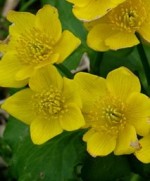 March marigold is a herbaceous perennial native to the Northern Hemisphere where it is found growing in marshes, stream edges, and other wet areas. It is a member of the buttercup family, Ranunculaceae, that also includes columbine, delphinium, and hellebore, and is not related to marigolds (Tagetes). Plants form a mound of large, glossy, heart-shaped leaves on long stalks together with hollow branching stems that bear smaller leaves and clusters of flowers. The bright yellow flowers are 1-2″ across, appear in the spring, and resemble those of the common buttercup. They are made up of 5-9 waxy sepals that look like petals, and numerous conspicuous stamens surrounding a central bundle of carpels each of which produces numerous seeds. The flowers provide nectar for butterflies and bees while their leaves provide shelter for small insects such as beetles and for other animals such as frogs. The seeds are attractive to birds and small rodents such as chipmunks and voles. Marsh marigold is an excellent choice for the wettest part of a rain garden and can also be used on the edge of ponds or streams, and in bog and water gardens.
March marigold is a herbaceous perennial native to the Northern Hemisphere where it is found growing in marshes, stream edges, and other wet areas. It is a member of the buttercup family, Ranunculaceae, that also includes columbine, delphinium, and hellebore, and is not related to marigolds (Tagetes). Plants form a mound of large, glossy, heart-shaped leaves on long stalks together with hollow branching stems that bear smaller leaves and clusters of flowers. The bright yellow flowers are 1-2″ across, appear in the spring, and resemble those of the common buttercup. They are made up of 5-9 waxy sepals that look like petals, and numerous conspicuous stamens surrounding a central bundle of carpels each of which produces numerous seeds. The flowers provide nectar for butterflies and bees while their leaves provide shelter for small insects such as beetles and for other animals such as frogs. The seeds are attractive to birds and small rodents such as chipmunks and voles. Marsh marigold is an excellent choice for the wettest part of a rain garden and can also be used on the edge of ponds or streams, and in bog and water gardens.
Type: Herbaceous perennial
Size: 1-2′ H x 1′ W
Light: Full sun to part shade; needs some shade in hot climates to avoid drying out
Soil: Wet, boggy
Hardiness: Zones 3-8
Beneficial Insects Attracted: Butterflies, honey bees, hoverflies, beetles